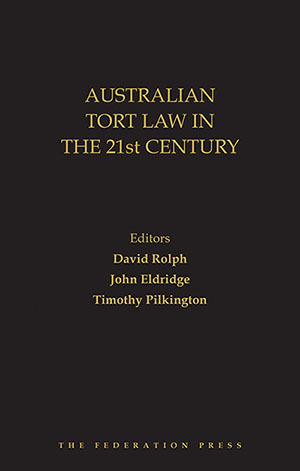- Winter 2024
- Australian Tort Law in the 21st Century By David Rolph, John Eldridge and Timothy Pilkington (eds) (The Federation Press, 2024)
Australian Tort Law in the 21st Century By David Rolph, John Eldridge and Timothy Pilkington (eds) (The Federation Press, 2024)


It has been said that formal separation of the common law of Australia from the common law of England may be dated with precision to the abolition of appeals to the Privy Council from all Australian Courts.[1]
However, as Mark Lunney has convincingly demonstrated,[2] a distinctly Australian law of torts emerged in the first half of the 20th
century, partly as a result of local legislative reform but also as a result of Australian judicial divergence from English case law.
This collection of essays about Australian tort law in the 21st century begins in the 19th century with an essay by Mark Leeming, ‘Colonial Innovation in the Australian Law of Torts’ (ch 1). As Paul Finn once wrote, an understanding of legal history ‘has uncommon importance in the coherent development of legal principles’.[3] In this chapter, Leeming returns to a topic which he has dealt with elsewhere at length[4], namely the interaction between statute and judge-made law, and considers the enactment of ‘claims against government’ legislation as an illustration of the contribution made by colonial legislatures to a distinctively ‘Australian’ law of torts.
A number of the essays are somewhat less ‘Australian’ in focus than the title of the collection might indicate. Professor Dyson’s essay, ‘Intention in Tort: Where it comes from and where it’s going’ (ch 2), discusses the role of intention in tort law, predominantly by reference to non-Australian authority. James Goudkamp’s essay, ‘New Torts’ (ch 3), is a similarly non-Australian review of the circumstances in which new torts come to be identified (although the brief section on so-called ‘dead torts’ has a distinctly Australian flavour).
Subsequent chapters, however, return to an Australian focus. Ellen Rock’s ‘Government Liability and the Will of Parliament’ (ch 4) is a survey of recent cases considering the scope of government liability in tort. There are then essays addressing particular elements of liability in negligence: Gemma Turton’s ‘Factual Causation: The Sensible Decline of Common Sense and the Mystery of the “Exceptional Case”’ (ch 5) and Barbara McDonald’s ‘Scope of Liability and Remoteness of Damage: A Final Limit on Responsibility for Negligence in Australia’ (ch 6). Each address different aspects of the statutory reforms to the law of causation. Jodi Gardner’s ‘”A Risk by Any Other Name”: Rejecting volenti in Australian Tort Law’ (ch 8) surveys the case law in relation to assumption of risk and analyses the relationship between the doctrine of volenti at common law and the statutory defences enacted as part of the Ipp reforms.
One difficulty with a collection of essays such as this is that in situating a particular doctrine within its historical development as a springboard for saying something meaningful about its future, either the historical context or the prognostication as to its future (or both) inevitably suffer. This is illustrated by Warren Swain’s ‘Vicarious Liability: Antiaris toxicaria in Australia’[5] (ch 8), which provides an historical survey of the development of the law of vicarious liability that is altogether too brief, and does not leave room to provide anything other than a cursory summary of the recent 21st-century case law, merely noting, without really exploring, the tensions between the recent decisions of the House of Lords, the Supreme Court of the United Kingdom (curiously referred to as the English Supreme Court), and the High Court of Australia. Apart from noting the latter’s recent consideration of vicarious liability in CCIG Investments Pty Ltd v Schokman [2023] HCA 21, there is no discussion of the challenge issued by Edelman and Steward JJ in that case to reconceptualise vicarious liability.
A more satisfactory balance is arrived at in Carolyn Sappideen’s excellent survey of the interaction between torts law and the contract of employment: ‘Tort and Employment: Reflections on Changing Ideas of Responsibility and the Adaptability of Torts Law’ (ch 9) and in Prue Vines’ discussion of blameworthiness in the law of negligence: ‘Negligence, Morality and Apologies: Assessing Responsibility in the Real World’ (ch 10).
The collection concludes with an essay by Stephen Puttick and David Winterton, which analyses the High Court’s relatively recent decision in Arsalan v Rixon [2021] HCA 40: ‘Repairing the Compensatory Principle in Negligence: “Loss of Amenity” and the Justifiable Scope of Damages Liability’ (ch 11) and a discussion by David Rolph on the increase in litigation in Australia involving injurious falsehood: ‘Injurious Falsehood: A Tort Resurgent’ (ch 12).
Overall, this collection of essays provides a useful starting point for a more detailed consideration of each of the topics they individually consider. Their historical analysis is sufficient to provide the context for the discussion, but one will mostly want to delve into the footnotes for a more detailed treatment of that history. They usefully ask many questions about the future, paving the way for future authors (and practitioners and judges) to more boldly and comprehensively develop the law of tort (or torts) in the future.
ENDNOTES
[1] See S Gageler’s review, ‘Australian Contract Law in the 21st Century. Edited by John Eldridge and Timothy Pilkington (The Federation Press, 2021)’ [2022] Cambridge Law Journal 197.
[2] M Lunney, A History of Australian Tort Law 1901–1945: England’s Obedient Servant? (Cambridge University Press, 2018).
[3] PD Finn, ‘Foreword’ in JT Gleeson, RCA Higgins and JA Watson (eds), Historical Foundations of Australian Law Volume I (The Federation Press, 2013).
[4] M Leeming, The Statutory Foundations of Negligence (The Federation Press, 2019); M Leeming, Common Law, Equity and Statute (The Federation Press, 2023)
[5] Antiaris toxicaria is the scientific name for the Upas tree, traditionally used to make poison darts. Its use in the title is a reference to Thomas Baty’s description of ‘the poisonous properties of vicarious liability’.
